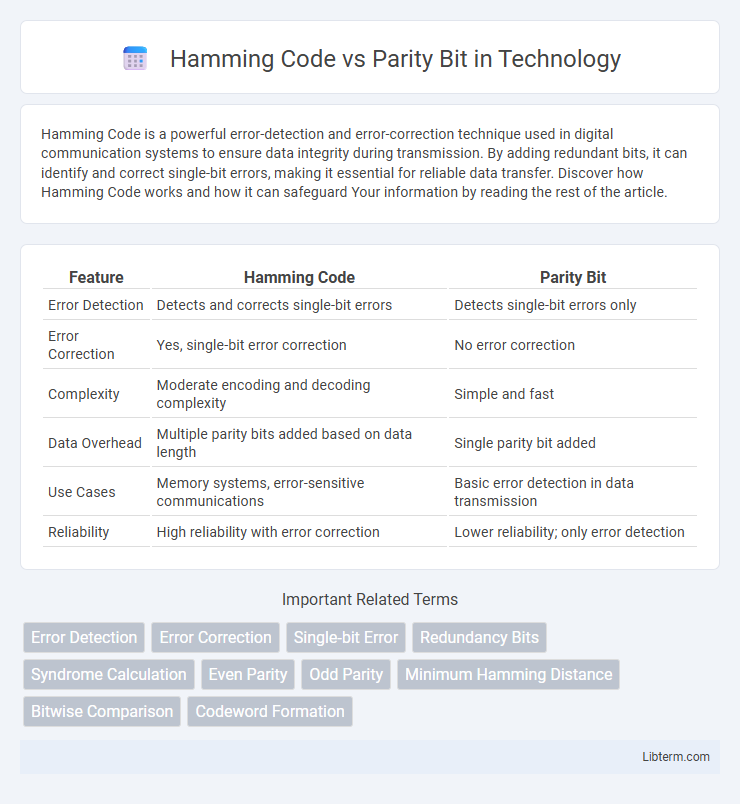Hamming Code is a powerful error-detection and error-correction technique used in digital communication systems to ensure data integrity during transmission. By adding redundant bits, it can identify and correct single-bit errors, making it essential for reliable data transfer. Discover how Hamming Code works and how it can safeguard Your information by reading the rest of the article.
Table of Comparison
| Feature | Hamming Code | Parity Bit |
|---|---|---|
| Error Detection | Detects and corrects single-bit errors | Detects single-bit errors only |
| Error Correction | Yes, single-bit error correction | No error correction |
| Complexity | Moderate encoding and decoding complexity | Simple and fast |
| Data Overhead | Multiple parity bits added based on data length | Single parity bit added |
| Use Cases | Memory systems, error-sensitive communications | Basic error detection in data transmission |
| Reliability | High reliability with error correction | Lower reliability; only error detection |
Introduction to Error Detection and Correction
Hamming Code and Parity Bit are fundamental error detection and correction techniques in digital communication systems. Hamming Code not only detects but also corrects single-bit errors using multiple parity bits strategically placed within the data. In contrast, the Parity Bit method primarily detects single-bit errors by adding a single parity bit to the data stream, offering simpler but less robust error handling.
What is a Parity Bit?
A parity bit is a simple error-detection mechanism added to a string of binary data to ensure data integrity during transmission. It works by making the total number of 1s either even (even parity) or odd (odd parity), allowing the detection of single-bit errors. Unlike Hamming Code, which can both detect and correct errors, a parity bit only detects errors and cannot specify their location.
How Parity Bits Work
Parity bits work by adding a single binary digit to a data set, ensuring the total number of 1s is either even (even parity) or odd (odd parity). This simple error-detection method identifies if a single bit error has occurred during data transmission but cannot pinpoint or correct the error. In contrast, Hamming codes use multiple parity bits positioned at specific intervals, enabling both error detection and correction in transmitted data.
Overview of Hamming Code
Hamming Code is an error-detecting and error-correcting code that enables the identification and correction of single-bit errors in data transmissions. Unlike a simple Parity Bit, which only detects errors, Hamming Code uses multiple parity bits strategically placed within the data to locate the exact position of an error. This method enhances data integrity in communication systems by enabling both error detection and correction, making it more robust than basic parity schemes.
How Hamming Code Works
Hamming Code works by adding multiple parity bits to specific positions within data bits to detect and correct single-bit errors automatically. Each parity bit covers a unique combination of data bits, allowing the system to identify the exact position of an erroneous bit through the calculation of syndrome bits. This method improves error correction capabilities beyond simple Parity Bit checks, which can only detect errors but cannot locate or fix them.
Key Differences: Hamming Code vs Parity Bit
Hamming Code and Parity Bit differ primarily in error detection and correction capabilities; Hamming Code can both detect and correct single-bit errors, while Parity Bit only detects single-bit errors without correction. Hamming Code uses multiple parity bits positioned at powers of two to encode data, enabling precise error location, whereas Parity Bit employs a single parity bit for the entire data block to indicate even or odd parity. The increased redundancy in Hamming Code results in improved reliability for noisy communication channels compared to the simpler but less robust Parity Bit approach.
Advantages and Disadvantages of Parity Bit
Parity bit offers a simple and cost-effective method for error detection by adding a single bit to data, enabling identification of single-bit errors during transmission. However, its major disadvantage lies in the inability to detect multiple-bit errors or locate the error position, limiting its effectiveness in more complex communication systems. Compared to Hamming code, parity bit provides minimal error correction capabilities and is best suited for basic error detection scenarios.
Advantages and Disadvantages of Hamming Code
Hamming Code offers superior error detection and correction capabilities by identifying and correcting single-bit errors, unlike Parity Bit which only detects errors without correction. It requires more redundant bits compared to Parity Bit, increasing data overhead and complexity in implementation. The advantage of Hamming Code lies in improved data integrity for critical communication systems, while its disadvantage is higher computational resources and reduced data transmission efficiency.
Use Cases and Applications
Hamming Code is widely used in computer memory systems and digital communication to detect and correct single-bit errors, ensuring data integrity in environments like RAM modules and satellite communication. Parity Bit finds its primary application in simple error detection scenarios such as serial communication interfaces and basic data storage, where only error detection--not correction--is needed. The choice between Hamming Code and Parity Bit depends on the criticality of data accuracy and system complexity, with Hamming Code preferred for fault-tolerant systems and Parity Bit suited for low-overhead error detection.
Choosing the Right Method for Data Integrity
Hamming Code provides advanced error detection and correction by identifying and fixing single-bit errors, making it ideal for critical data integrity in noisy transmission environments. Parity Bit offers a simpler, less resource-intensive method that detects only single-bit errors, suitable for applications with low error rates and limited processing capabilities. Choosing between Hamming Code and Parity Bit hinges on the required error correction strength, system complexity, and performance constraints.
Hamming Code Infographic

 libterm.com
libterm.com